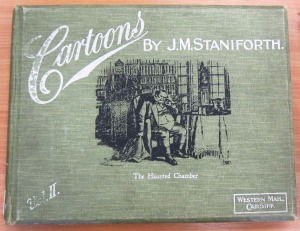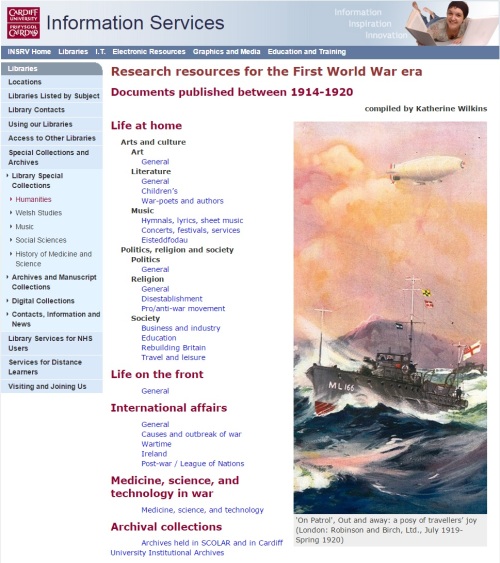Today, I want to talk about cartoons. Come again? Is this librarian a complete Looney Tune? That may well be a matter of opinion, but the subject of this post has certainly got me animated, so by the Power of Greyskull, let’s turn our attention to the renowned cartoonist:

J. M. Staniforth’s signature, Cartoons: originally published in the “Western Mail”, (Cardiff,Western Mail, 1908)
Joseph Morewood Staniforth was an editorial cartoonist best known for his work in the Western Mail (Cardiff’s daily paper), the Evening Express (Cardiff’s evening paper), and the News of the World (the Sunday paper).

Portrait of J. M. Staniforth, Cartoons: originally published in the “Western Mail”, (Cardiff, Western Mail, 1908).
I initially became aware of him through the work of Professor Chris Williams, who has been diligently documenting and digitising the wartime newspaper cartoons of this unique artist. It seems we have here in Special Collections and Archives possibly the only copy of Football Cartoons & Rhymes compiled by Staniforth and a writer named Idris, and when Chris asked to see it, judging from the title, I presumed he was researching some traditional banter ready for the impending Rugby Six Nations!

Rugby cartoon detail from J. M. Staniforth, Football cartoons & rhymes, (Cardiff, Western Mail, c. 1903)
However, I was soon to discover just how exceptional Staniforth’s work was, and indeed still is to anyone interested in the social, political, and cultural history of the late nineteenth and early twentieth centuries.
The fourth son of a saw repairer, Staniforth was born in Gloucester on the 16 of May 1863, and later grew up in Cardiff. At 15, he left school to train as a lithographic printer for the daily newspaper the Western Mail, whilst studying art in the evenings at the Cardiff School of Art which was initially established in rooms above the Royal Arcade in Cardiff city centre. Built in 1858, it is the oldest arcade in Cardiff, and, interestingly, the birthplace of our distant relative, Cardiff’s Free Library, set up through voluntary subscriptions above the St. Mary Street entrance to the arcade. But I digress! So back to the school of art, where another soon to be famous artist, the sculptor William Goscombe John was also learning his craft. Originally working with paint, Staniforth soon developed his technique in inks whereby with a fine pen and ink, he would compile his cartoon on paper which was then photographed onto a metal bloc used in the printing process. The Western Mail claimed to be the first regional newspaper to adopt this technique. He began drawing cartoons bearing his tell-tale monogram for the Evening Express and on occasions, for the Western Mail, where his skills as an illustrator were quickly spotted by the Mail’s editor, Henry Lascelles Carr, who swiftly transferred him to the editorial team. Following Carr’s takeover and restyling of the Sunday News of the World in 1893, Staniforth’s cartoons were given prime-place on the front page of every issue. By 1900, his cartoons were a regular feature in the Western Mail.

‘Martyrs of the Arena’, Cartoons: originally published in the Western Mail: Vol II, (Cardiff, Western Mail, c. 1910)
The News of the World and the Western Mail were amongst the first newspapers to use cartoons as a means of political and social commentary rather than purely comic distractions. Sir Francis Carruthers Gould is generally regarded as the first cartoonist on a British daily newspaper, drawing as he did for the Pall Mall Gazette from 1888 followed by the Westminster Gazette, and some examples of his work can be seen here in Special Collections. Staniforth, nevertheless, came to the fore just five years later, and by the early 20th century, the News of the World was selling over one million copies every week! Its circulation almost tripled by the time of Staniforth’s death in 1921 and was considered to be the largest in the world. The Western Mail too was a leading regional newspaper, its scope however was far from provincial in its aim, as the self-styled national newspaper of Wales, to report on the key national and international events of the day. Despite its conservative leanings, its readability and tempered journalism attracted a broad readership including Liberals, Nonconformists and Trade-Unionists. Thus, the potential reach of Staniforth’s continuous crop of cartoons was infinite.

J. M. Staniforth, Cartoons: originally published in the “Western Mail”: Vol II, (Cardiff, Western Mail, c.1910)
It is estimated that Staniforth drew over fifteen thousand cartoons over the course of his career, which coincided with one of the most tempestuous eras in modern history. 1898 – 1921 was not only a defining time in the history of the South-Wales coalfield and Labour relations, but in imperial and international affairs generally. Major domestic and international events such as the ‘Great Strike’ of 1898, the Boer War, The Great War, and the growing industrial unrest in the coal-fields, were keenly observed on the regular platform provided by Staniforth’s pen.
Viewed in this context, the scope of his cartoons is even more substantial. Some were published as single volumes, samples of which we are fortunate to hold as part of the Salisbury Library, such as Cartoons of the Boer War (Cardiff, 1902), Cartoons of the Welsh coal strike, April 1st to Sept. 1st, 1898 (Cardiff, 1898), and Cartoons of the Welsh revolt (Cardiff, 1905).

J. M. Staniforth, Cartoons of the Boer War: Vol. II, (Cardiff, Western Mail, 1902)
And that’s not all folks! Staniforth compiled a collection of nursery rhymes, and drew numerous picture postcards, funny and factual. These too are being digitised by Chris Williams on the sister site – Cartooning the Road to War.

J. M. Staniforth, Staniforth’s Nursery Rhymes, (Cardiff, Western Mail, 1902)
Let’s not forget that Staniforth was a trained artist. As a loyal member of the South Wales Art Society since its foundation in 1888, he regularly exhibited work at their annual exhibition, securing his own 3 week showing at a Cardiff gallery in 1916. He designed the costumes for the National Pageant of Wales held in 1909, including the famous dragon-encrusted dress worn by the Marchioness of Bute as ‘Dame Wales’. Staniforth was also commissioned to paint eleven panels depicting various themes from Shakespeare’s plays (the largest of which is 2m high, 1.2m wide) for Howells School for Girls, in Cardiff. These are currently being restored by specialist conservation architects and painters, and will be reinstated at the school in April this year.

Staniforth’s Romeo and Juliet at Howells School for Girls, Cardiff, courtesy of Michael Davies of Davies Sutton Architects.

Restoration work being carried out on Staniforth’s Romeo and Juliet at the workshop of specialist painting conservator, Rachel Howells (courtesy of Michael Davies).
Staniforth’s last cartoon appeared in the News of the World on the 11 of December, 1921. He passed away six days later due to ill-health. Tributes to the man and his work swamped the papers during the following weeks, casting him with the likes of Hogarth, Gillray, Leech and Tenniel. The then Prime Minister, David Lloyd George, observed the tremendous loss of ‘one of the most distinguished cartoonists of his generation’. Certainly, there is some weight behind Peter Lord’s assertion that Staniforth was ‘the most important visual commentator on Welsh affairs’. His unique portrayals offer an immediate and acute observation on some of the most historic and radical political and social events of the industrial and pre-war era. While historians may value the printed text over the sketch, visual sources can provide direct access to historical moments, capturing the initial pulsations of key events in our history. As Staniforth himself explained: ‘a good cartoon should be very acceptable… small though it be, it is a power of far reaching effect’. And so the moral of this blog-post is: never underestimate the potential of cartoons. They may be mere fun on the surface, but beneath their inky contours lies something far more meaningful. That’s all folks!
To see more of Staniforth’s work, visit:
http://www.roadtowarcartoons.org/
http://www.postwarworldcartoons.org/











 Political papers from the British Labour Party and Newport Labour Party on women’s issues; papers of the Labour MPs Ellen Wilkinson and Marion Phillips; the diary of social reformer Beatrice Webb; archives of the Women’s Labour League, journals by Sylvia Pankhurst, and a range of suffragette magazines;
Political papers from the British Labour Party and Newport Labour Party on women’s issues; papers of the Labour MPs Ellen Wilkinson and Marion Phillips; the diary of social reformer Beatrice Webb; archives of the Women’s Labour League, journals by Sylvia Pankhurst, and a range of suffragette magazines;

